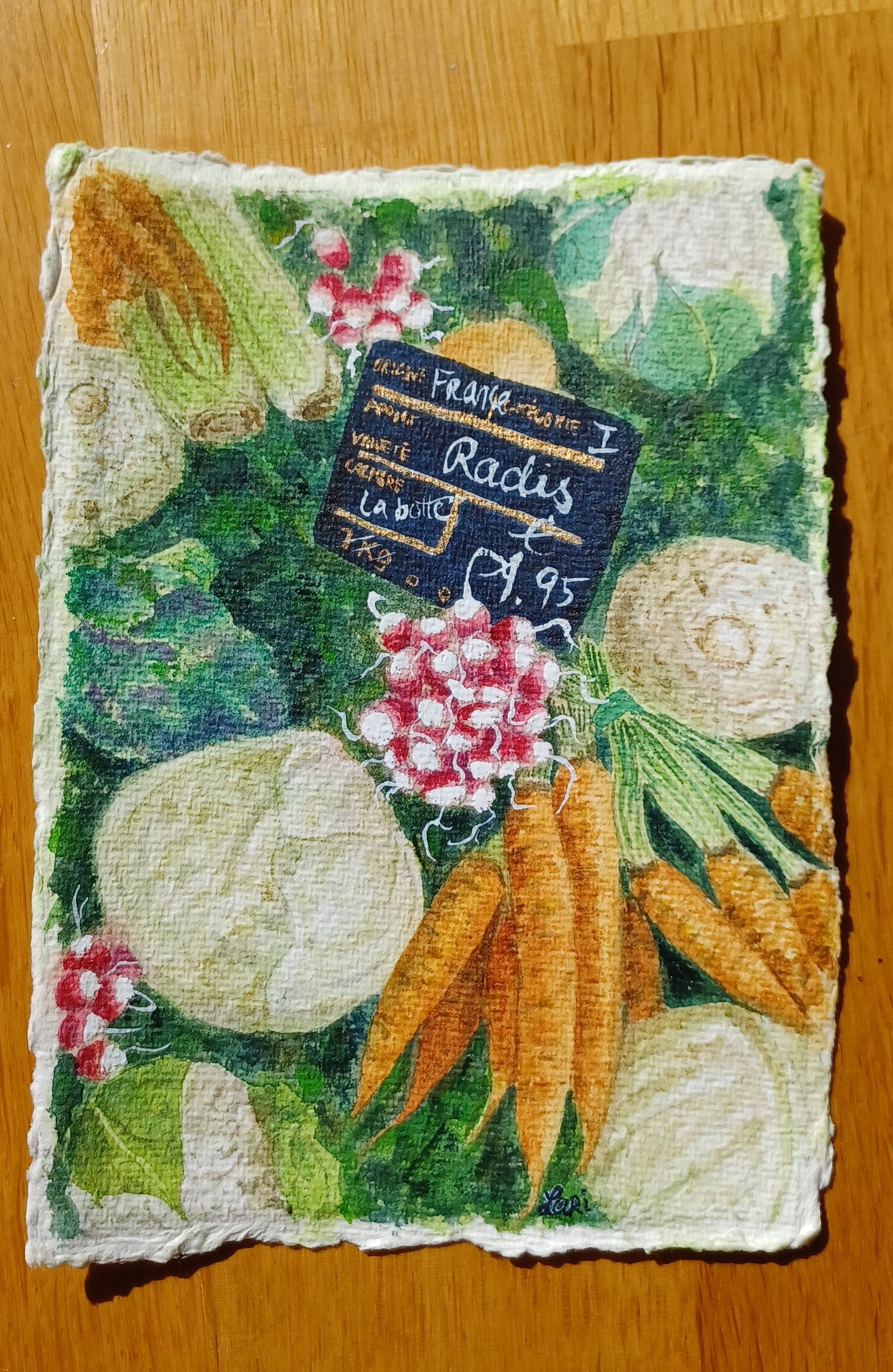I wrote about seasonality in my essay on butter, back in December of last year. We're now in the olive oil half of the year, and my one little remaining chunk of butter now sits, neglected, in his crinkly foil wrapper behind my chili oils, fermented seasonings, and fresh fruits that occupy my attention this time of year. He doesn't deserve that, I know, but that's the circle of life in my kitchen. The circle will be complete once I add him into one last poêlée, adding that rich touch that makes green vegetables even more irresistable.
"Seasonality" in business and economics is a fluctuation that happens regularly and predictably--think back-to-school sales, wintertime gift giving, summertime tourism. (As an artist trying to eke out a living, I understand and begrudgingly admit that this seasonality affects me too.)
Food trends here in France are seasonal--people love to "elevate" international foods (think burgers and Mexican food), introduce the public to "exotic" ingredients (the newest in vogue ingredient is yuzu), which inevitably produce a slew of bland, unimaginitive recipes.
Attention spans, too, seem to be seasonal. In the United States, June is Pride Month, and when the newest federal holiday, Juneteenth, is commemorated. But like Black History Month (February), Asian-American and Pacific Islander Heritage Month (May) and Hispanic Heritage Month (September-October) among others, US-Americans are encouraged to think about social injustice and inequality (but not too hard). But on July 1st, the corporate rainbows will be replaced and mainstream talk of allyship and solidarity will go back in the fridge until next year.
But food seasonality is about eating with the seasons: consuming food which is produced while it grows naturally (either locally, or somewhere else in the world). NGOs and contemporary media tell us eating locally produced food in season is ideal--it travels a shorter distance and helps support local agriculture.
It sounds like a great way to live, but not everyone has the means to do so. "Education" or "awareness" cannot shift the responsability from the broken and neglectful food system to the individuals who are just trying to get by within it. Sometimes, the closest and most affordable option is buying canned, dried, or frozen veg and beans from your local superstore.
Diets like the 100-mile diet have become popular in recent years (though I'm not sure how revolutionary it is to rebrand indigenous foodways for a thought experiment to gain freedom from reliance on grocery stores and processed food). But the carbon footprint linked with transporting food across distances is not the only problem to consider. Food production (consider beans and lentils versus meat), processing, packaging, and food waste also contribute to the carbon footprint of our food.
And what if local farms rely heavily on pesticides and exploitative labor practices? What if there isn't food produced locally? What if you can't afford to buy local? What if you live in a food desert with limited transportation?
Depending on where you live in the world, your local food systems may also be disrupted by foreign crops that are subsidized (and therefore cheaper), replacing local crop varieties. Local agriculture may be actively depressed by Minority World countries' (aka. former colonial powers) food aid policies.
(See my previous essays that discuss wheat flour in Tunisia and land redistribution in Puerto Rico). Local farming initiatives exist to help reduce food insecurity and revalorize local biodiversity, but they often fight an uphill battle. (See this article on small-scale farming in Puerto Rico).

Back in the day, showing off your wealth (on Western tables) meant lush, multi-course meals prepared with strange and far-flung ingredients, unique meats and exotic spices prepared in elaborate fashion. Status meant spices: having allspice, black pepper, cinnamon, and vanilla (among others) made their food special, inaccessible.
Today, spices are much more accessible--though whether one uses them sufficiently is another discussion... (yes, my pet peeve is bland food!) So how can one distinguish the food of the "haves" versus the "have-nots?"
One way is through performative seasonality. This month in Vittles newsletter, Sheena Patel wrote about what she calls "New Age Bio-Dynamic Porn Barons," or social media food influencers that show off the gorgeous, seasonal produce to which they have access. That aesthetically rustic local veg is acquired via their buying power and geographical access, which isn't pictured in the covetous parasocial dynamic of social media.
Having the means to buy local heirloom vegetables looks great, and has the added bonus of exonerating oneself from interacting with hard questions. If you can buy your way into an exemption from discussing your carbon footprint, that puts you a step ahead of those povvos who must resort to plastic-wrapped food from some chain store. (If you’ve never seen ShabazSays, then click here, watch, giggle, and come back here.)
I wrote in March about French farmer's markets and the commodification of the French countryside. The truth about those quaint markets is that, you're not helping farmers if you're not buying local produce. At any typical outdoor French market, the produce's country of origin is clearly marked, and a lot of what is sold is not, in fact, grown in France. Though I try to do my best to buy local, I still buy stuff grown elsewhere.

I live in a country that, 10 years ago, I had no familiarity with. I do the local markets and buy ingredients--many of which I've had to learn how to prepare correctly. In 10 years, I've learned to rinse my lamb's lettuce several times; to blanch the red escarole before putting it in my saucisses-lentilles; to pre-cook endives with a touch o'sweet before baking them into a creamy gratin; to figure out what the hell the different meats and pâtés are at the butcher.
I eat with gusto, but these are not the foods I grew up on, nor the foods I crave when I need something comforting. No, for that I make the rounds of my markets, where I can find piments végétariens (similar to ajíes), plantains, corn meal, bacalao (salt cod), cheddar cheese, and green bananas. Eating local is fine and dandy because I have access to it, but I cannot sacrifice “my” food. Unfortunately, the more "ethical" food choices do not always reflect my values or food traditions. I am able to sidestep seasonality because of my access to well-appointed shops in my city.
Seasonality is temporality. It is temporary. Enjoy the moment because it's fleeting, carpe diem and all that... It sounds nice, but who actually lives like that? I very often succeed at chickening out of things, saying "no"/"pass," with the erroneous belief that there will be a "next time" that I'll be in a better place to say "yes." I do it because I hate being put on the spot, but I still detest that quality about myself.
But I find redemption in the seasonality of food, precisely because I count on the fact that "there's always next year." I realize this is a bold assumption of that speaks to my privilege: it relies on steady climate conditions year after year, and my continued financial and geographic access to ingredients.
NEW: Fresh from the Studio
I am now available for art commissions! Illustrations for your newsletter, paintings for your home, hand-bound books for your thoughts... I have a commission form available on my website.



Thank you for reading! I'll be back next month with a new TIDBITS for paid subscribers, followed by the next RENDERED essay in mid-August. You can follow my art journey on Instagram and Youtube, and check out my web shop for prints, cyanotypes, stickers, and original art.
RENDERED is a one-woman production, and your support is appreciated! If you're hungry for more content in audio format, consider a paid subscription. For 5€, you can get a month's worth of access to my narrated essay series, TIDBITS. Yearly subscribers get a RENDERED logo sticker and zine, and Art Collectors receive a custom painting.
Be well, take care of your heart, and I'll be back next month.
Bibliography
Etmanski, Catherine. "A critical race and class analysis of learning in the organic farming movement." Australian Journal of Adult Learning Volume 52, Number 3, November 2012. https://files.eric.ed.gov/fulltext/EJ1000191.pdf
Irtiqa Shabir, Kshirod Kumar Dash, Aamir Hussain Dar, Vinay Kumar Pandey, Ufaq Fayaz, Shivangi Srivastava, Nisha R. Carbon footprints evaluation for sustainable food processing system development: A comprehensive review, Future Foods, Volume 7, 2023, 100215, ISSN 2666-8335, https://doi.org/10.1016/j.fufo.2023.100215.
Macdiarmid, Jennie I. “Seasonality and Dietary Requirements: Will Eating Seasonal Food Contribute to Health and Environmental Sustainability?” Proceedings of the Nutrition Society, vol. 73, no. 3, 2014, pp. 368–375., doi:10.1017/S0029665113003753. https://www.cambridge.org/core/journals/proceedings-of-the-nutrition-society/article/seasonality-and-dietary-requirements-will-eating-seasonal-food-contribute-to-health-and-environmental-sustainability/08545F71A12EF0FE233E8D1DEFEF227A
Mercado, Angely. "Puerto Rico’s Small-Scale Farming Revolution." PBS, 5 Jul 2022. https://www.pbs.org/wnet/peril-and-promise/2022/07/puerto-ricos-small-scale-farming-revolution/
Patel, Sheena. "Rich People Peasantcore." Vittles, 5 June 2023. https://vittles.substack.com/p/rich-people-peasantcore
Puckett, Susan. "Eating seasonally and locally has many benefits. Is fighting the climate crisis one of them?" CNN, 27 Sep 2022. https://edition.cnn.com/2022/09/14/health/seasonal-food-produce-lbg-wellness/index.html
Taylor, Derrick Bryson. "Juneteenth: The History of a Holiday." New York Times, Updated 19 June 2023. https://www.nytimes.com/article/juneteenth-day-celebration.html



